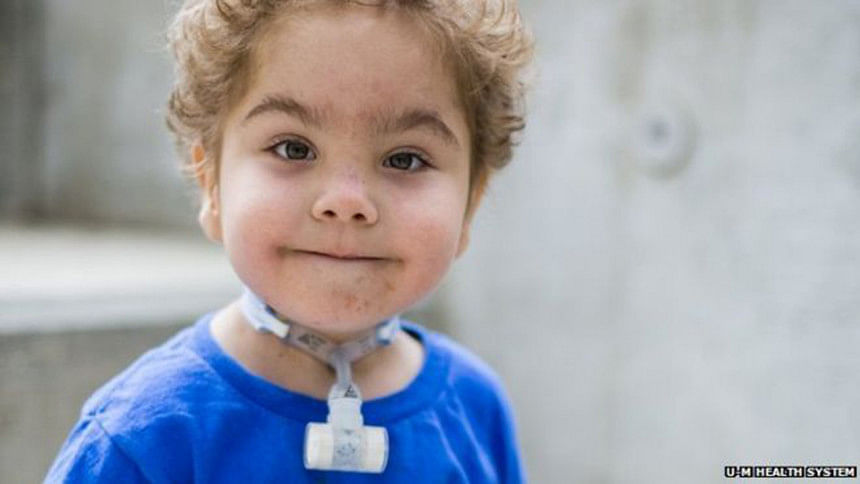3 babies saved by 3D windpipe

Three babies have been saved from a life-threatening condition by using 3D printed windpipe splints to help them breathe, a pilot study reveals.
The patients suffer from a rare illness that means their windpipes can collapse and prevent air getting in.
The device was rapidly customised for each individual. And unlike most 3D implants, it was made of material that changed shape as the children grew.
The research appears in Science Translational Medicine.
Last resort
Due to the small number of children involved in the study it does not prove it will work in every case.
But it does show the splints could be a promising option for a condition that has no cure, researchers from CS Mott Children's Hospital at the University of Michigan say.
One in 2,000 children have tracheobronchomalacia - a weakening and collapse of the windpipe (trachea) that would normally allow air to travel to the lungs.
Those with the most severe form have a poor chance of surviving. But if they can get to the the age of three, their windpipes have often strengthened enough to allow them to breathe well.
Kaiba Gionfriddo had the procedure when he was just three months old. He was in a critical condition, needing intensive care because his body was not getting the oxygen it needed.
So doctors sought emergency approval to use the device as a a last resort.
Lead researcher Dr Glenn Green described it as a ground-breaking case.
Kaiba is now "an active, healthy three-year old in preschool with a bright future", researchers said.
Dissolving device
Almost three years later the splint shows signs of melting away as planned. And doctors say his windpipe appears strong enough for him to breathe without its support.
April Gionfriddo, Kaiba's mum, said: "The first time he was hospitalised, doctors told us he may not make it out.
"It was scary knowing he was the first child to ever have this procedure, but it was our only choice and it saved his life."
The team have now carried out the surgery on two other children.
Both are doing well and are back at home, though one continues to need a machine to help his breathing, because of problems the splint could not address.
Dr Patrick Finlay, of the Institution of Mechanical Engineers, described it as an advanced piece of engineering.
He said: "The problem represents some formidable difficulties.
"You have to construct something that can cope with growth and coughing and sneezing.
"And they seem to have done this - it is very exciting."
He said the splint could be thought of as similar to a section of vacuum cleaner pipe that had been split in the middle.
It is customised to match the exact anatomy of each patient and made of a bio-absorbable material.
Doctors sew it in place on the outside of the windpipe as an incomplete ring.
The aim is for it to provide support without constricting growth.
Prof Paolo De Coppi of Great Ormond Street Hospital described this as a very attractive way of doing the procedure.
He said: "Other options can include internally placed stents - but these can cause bleeding and other complications.
"It is very encouraging news to see at three years that it appears safe and effective in this child."
US researchers have filed a patent on the device and are now embarking on a larger trial.

 For all latest news, follow The Daily Star's Google News channel.
For all latest news, follow The Daily Star's Google News channel. 



Comments